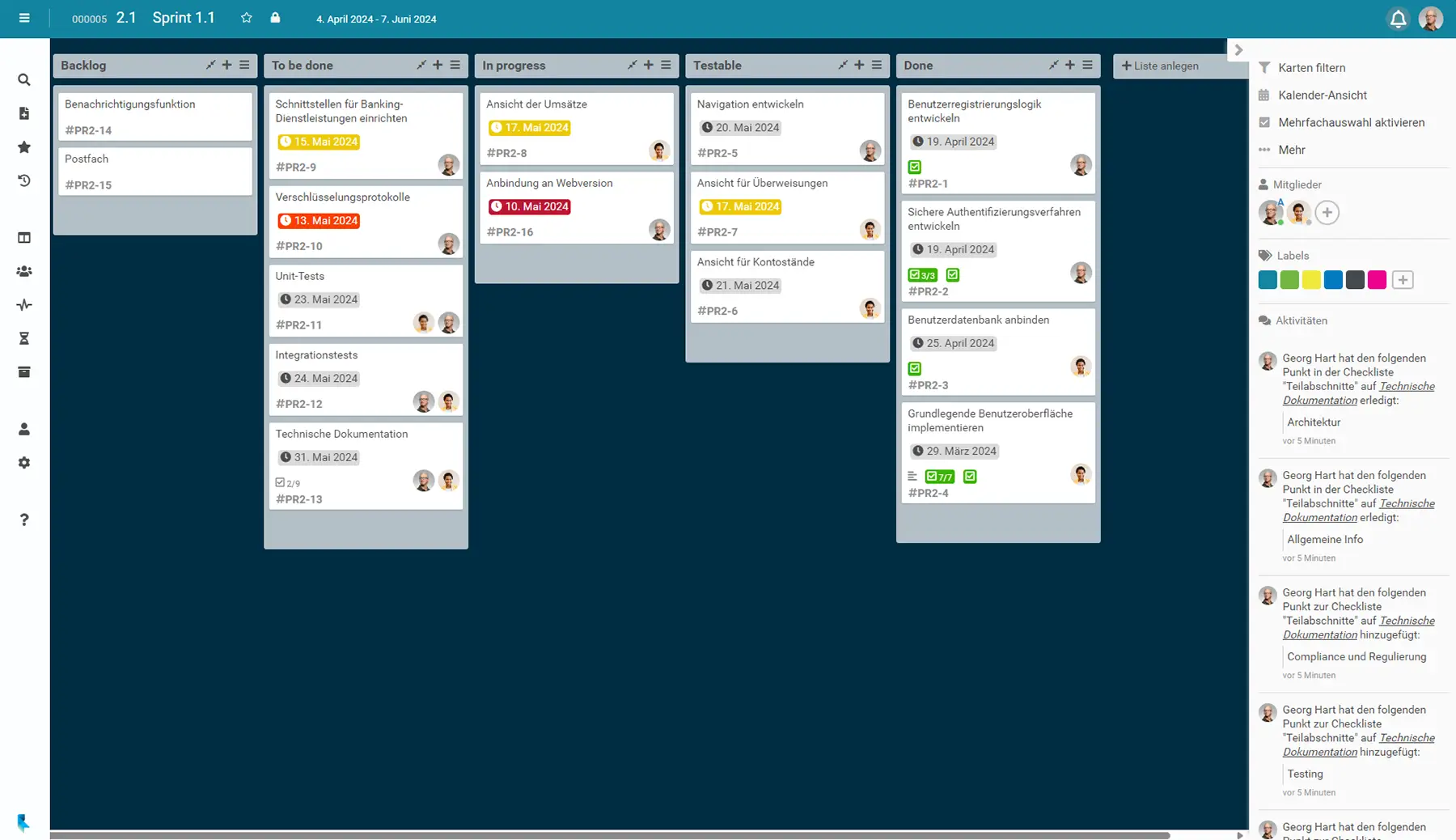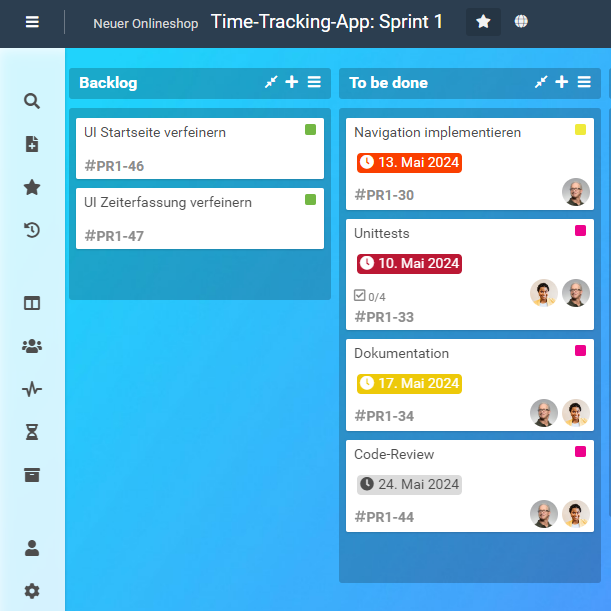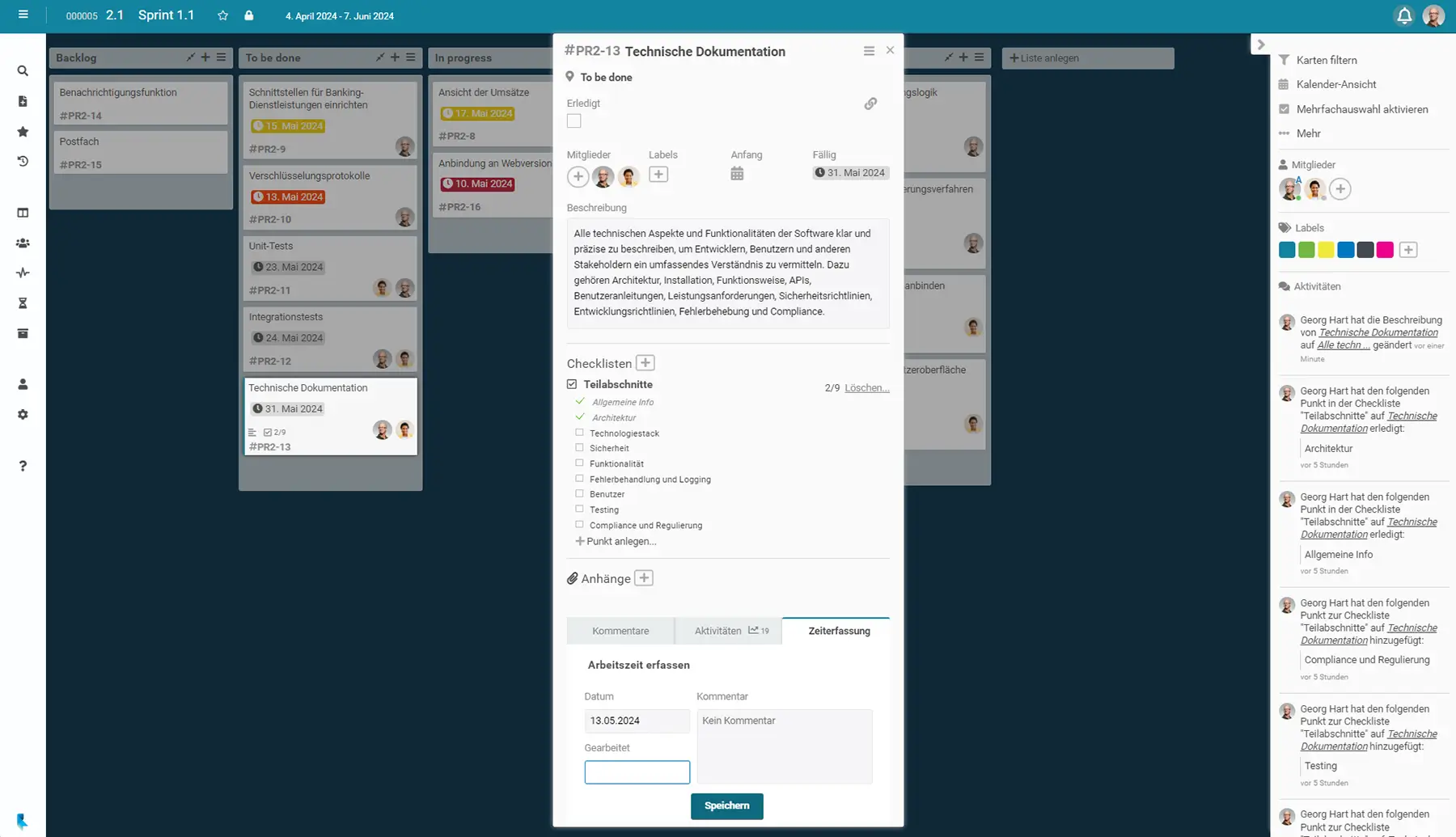Task Planning in Project Management for Project Success!
| Translated by Julian Hammer
Task planning is the core of any successful project. It is the path that guides the team through the complex jungle of tasks, deadlines, and milestones. Careful task planning is therefore decisive to make sure that the project runs smoothly, time and resources are used efficiently and the defined objectives are achieved. In short, task planning is crucial to ensuring that everyone in the team knows what needs to be done, when it needs to be done and how it is to be done.
How does task planning in project management contribute to the success of a project? Task planning is about identifying, organizing, assigning, and scheduling the various tasks required to achieve the project goals. Only such solid task planning allows the team to optimally use its resources, keep deadlines, minimize risks, and increase the efficiency and effectiveness of the project team significantly.
This article shows, a.o., the essential role of task planning in project management, challenges to be expected, advantages of the use of project management tools and takes a closer look at the PLANTA Project software for smooth task planning. This way you and your team will be ideally equipped to navigate through the complex jungle of task management with confidence in the future.
What is task planning in project management?
Task planning is an essential part of project management. Itis the process of identification, organization, assignment, and planning of different tasks, which are necessary to achieve the project objectives. Solid task management decides whether a project will be successful ot whether it will fail. It provides the various team members and stakeholders with a clear roadmap for adhering to schedules and achieving the defined goals.
Phases of Task Planning
Task planning in project management goes through various phases to ensure that the project is implemented efficiently and successfully:
- Objective definition: In this phase, the project objectives are defined and the tasks required to achieve the objective are identified.
- Structuring: The identified tasks are structured hierarchically and divided into logical work packages.
- Scheduling: The tasks are scheduled by defining start and end dates and observing dependencies between the individual tasks.
- Resource assignment: The required resources like personnel, budget, and materials, are assigned to individual tasks.
Monitoring and control: During the course of the project, the progress of the individual tasks is monitored, deviations from the plan are identified and appropriate measures are taken to bring the project back on track.
Methods and Tools of Task Planning
Modern project management tools take the dynamic world of project management to a whole new level. They facilitate work planning since communication and documentation take place in a centralized manner. There is more transparency, efficiency, and collaboration. What other methods and tools can you use profitably in the various phases of task planning and which project management software is among the most popular?
- Gantt charts: Visual display of the timing of the tasks and their interdependencies.
- Network technology: Here, the tasks and their dependencies are mapped in a task network to determine the critical path and the optimal schedule.
- Kanban boards: This method visualizes the workflow by organizing tasks in columns which correspond to the different work phases (e.g. “Backlog”, “To be done”, “In progress”, “Testable”, “Done”).

- Project management software: There are numerous software solutions which are especially designed for task planning in project management. They allow for the creation of task lists, the assignment of resources, the definition of schedules, and the monitoring of project progress. The most popular tools include Microsoft Project, Asana, as well as the software products by PLANTA.
Why is task planning important for project management?
Task planning plays a decisive role in the success of your project for several reasons. First of all, it serves to avoid delays as it defines the project time line in depth. As a result, every team member knows what to do and when to do it, which significantly reduces the risk of delays.
Secondly, efficient task planning allows for budget control. By optimizing the use of resources, including budget and personnel, budget overruns can be avoided and the financial health of the project can be ensured.
Thirdly, customer requirements can be set out by in-depth task planning and their implementation can be defined with precision. The clear definition of requirements enables quality assurancefor the project and ensures customer satisfaction.
Negative consequences of insufficient task planning
Insufficient task planning can bring about serious negative consequences. Without clear timeline and priorities it is difficult to determine at what time tasks should be completed and which tasks are the most important and relevant. This can lead to delays in the projectand a budget overrun. Furthermore, insufficient resource planning leads to a project budget overrun since additional costs incur as a result of efforts to eliminate delays or quality problems. Furthermore, the absence of clearly defined requirements affects the quality of your work , which, in the worst case, can lead to customer complaints and a negative reputation for the entire project team and company.
Examples from Practical Experience
A study by Project Management Institute (PMI) from 2017 underlines the importance of careful project planning. According to the PMI, 14% of all projects in the software sector fail due to inadequate project planning. And that’s not all. Furthermore the study shows that 31 % of the projects do not achieve their objectives, 43 % overrun their budget, and 49 % cannot keep their deadlines. These numbers underline the importance of solid task planning in project management. With a well-thought-out plan that takes your objectives and deadlines into account and the right tools, you can avoid these problems from the outset.
What tasks incur in the course of task planning?
Task planning in project management comprises several important steps to ensure that your project runs smoothly:
- Identification of the main tasks: The first step is the identification of the main tasks required to achieve the project objectives.

- Subdivision of the main tasks: The main tasks identified are further divided into smaller, clearly structured work packages, which can then be processed by the team members.
- Definition of milestones: Milestones are defined to mark important points in the course of the project and to monitor progress.
The next step is scheduling, where start and end dates are defined for the tasks and dependencies between the tasks are considered. In the subsequent resource assignment, the required resources, such as personnel, budget, and materials are assigned to the individual tasks. After all it is important to prioritize the tasks to make sure that the most important tasks are the first to be completed.
Prioritization Methods and Their Positive Impact
You can use different prioritization methods for your task management, including:
- Eisenhower matrix: Tasks are subdivided into four categories: important and urgent, important but not urgent, urgent but not important, neither important nor urgent.
- MoSCoW method: Tasks are subdivided into four categories: Must, Should, Could, Would.
- ABCDE method: Tasks are ranked by their priority from A (very important) to E (unimportant).
The prioritization of tasks has several positive effects on your project team. Efficient time management allows to complete critical tasks in good time by prioritizing tasks in accordance with their urgency. This helps to reduce stress and promotes a healthier working environment since there is clarity about which tasks require immediate attention.
Furthermore, focusing on important tasks increases the overall productivity of the team. Delegating tasks that are urgent but not important strengthens team spirit and promotes individual skills, which in turn improves collaboration in the team.
Finally, by eliminating or deferring unimportant tasks, you can make sure that time and resources are not wasted on irrelevant activities. This enables a stronger focus on tasks that have the greatest influence on the success of the project.
What impact does task planning have on resource management?
Task management has a direct influence on resource planning in project management. Effective task planning allows you to assign resources like personnel, budget, and materials with precision. Detailed task planning means that resource requirements are clearly defined from the outset and can be managed accordingly by the team members. This allows for an optimal use of available resources since the resource requirements are already defined at the beginning of the project.
A good task planning thus helps to avoid resource bottlenecks and to ensure an efficient use of available resources. This leads to a better control over project costs and helps to keep your project within the defined time and budget frame.
What are the challenges of task planning in project management?
As a project manager, you often face several challenges when planning tasks in project management. By proactively managing these challenges, you can improve the effectiveness of your task planning and ensure the success of your project.
Unclear or incomplete requirements lead to difficulties in the identification and allocation of tasks. This can lead to misunderstandings, incorrect prioritization, and inadequate allocation of resources, which jeopardizes the success of the project. Project managers can proactively tackle this challenge by ensuring that requirements are clearly defined and understood. Regular communication with stakeholders is crucial to clarify and refine requirements.
Unforeseen changes in the project environment, such as new requirements or resource bottlenecks, impair the initial task planning. They result in delays, budget overruns and quality problems. Flexible planning approaches such as agile methods are the key to success here. Regular reviews and adjustments to task planning help to respond to changes in good time and keep the project on track.
Insufficient communication and collaboration between team members result in inconsistencies in task planning. It leads to misunderstandings, duplication of work, and unfulfilled tasks. By establishing clear communication channels, you ensure that all team members are regularly informed about the status of tasks. Using project management tools to centrally document and track tasks can also help to significantly improve collaboration.
In Scope Creep, the project scope is continuously extended after project start. Scope Creep leads to an overload of resources, which in turn leads to budget overruns, delays and quality problems. The original project objectives and requirements are becoming increasingly unclear. To proactively tackle scope creep, project managers should define clear project boundaries and communicate these with stakeholders. Regular reviews of the project scope and careful change control help you and the project team to identify and react to unwanted changes at an early stage.
What are best practices for effective task planning?
When talking about project management, effective task planning is indispensable. Here are 10 essential tips on what should not be missing from your task planning:
- Define objectives: By applying the SMART criteria, objectives can be defined in a more clear and measurable way which improves planning. The SMART objetives is decisive for efficient task planning: First of all, objectives must be defined clearly and specifically and they must contain specifications on persons involved, location, time, and purpose. Secondly, they must be measurable so that the progress can be observed and evaluated by all team members. Thirdly, the objectives must be accepted by all those involved so that they also motivate them. Furthermore, they should be realisticand achievable with the available resources. Finally, all objectives must be scheduledby defining a clear deadline for adhering to the project schedule.
- Prioritization of tasks: Prioritization allows you to keep your focus on the most important and urgent tasks. As a result, resources are used efficiently, schedules are adhered to and project goals are successfully achieved. The Eisenhower principleis a proven method for task prioritization which helps you to categorize tasks by urgency and importance. This approach allows you to focus on the essentials and optimize the productivity and efficiency of your team. The Eisenhower matrix divides tasks into four categories: Urgent and important (complete immediately), important but not urgent (plan), urgent but not important (delegate) and neither urgent nor important (eliminate).
- Set clear deadlines: Clear time lines help with successful time management and keep the project on track. Gantt charts can help you with this since they offer a clear visualization of the chronological sequence of tasks.
- Allocate tasks: The allocation of tasks in accordance with skills and experiences of team members is decisive. A strength-weakness analysis can help you to find the right team member for any task. Project management tools also provide valuable support in the distribution of tasks.
- Continuous monitoring adjustments: Regular monitoring processes like status meetings and the use of project management software with realtime dashboards facilitate continuous monitoring of the project progress. In order to be able to measure the success of the project, it is advisable to define suitable KPIs in advance.
- Encouraging team communication Modern communication tools improve the exchange of information within the team as well as collaboration.
- Risk management: A risk management plan allows potential problems to be identified, evaluated and minimized. This way you can tackle uncertainties in the project proactively.
- Obtaining feedback: A feedback loop presents a systematic method for obtaining feedback from team members and stakeholders on a regular basis and to analyze and implement it. The method ensures continuous improvement and effective communication throughout the course of the project.
- Work life balance: Promoting a healthy work-life balance is crucial for the long-term success and well-being of any project team. Balanced task planning that takes breaks and free time into account, helps to avoid overwork and increases motivation and productivity.
- Training and development: Continuous training of the team with regard to project management methods, tools and their area of responsibility is crucial for increasing efficiency and concluding a project successfully. In a constantly changing world of work, it is essential that teams keep their skills and knowledge up to date.
What advantages does the use of project management tools offer for task planning?
The use of project management tools offers numerous advantages for task planning. They include improved efficiency and effectiveness since many aspects of task planning are automated and allow for a more simple organization, assignment, and monitoring of tasks.
Project management tools furthermore promote better collaboration and communication by allowing teams to save tasks and project information centrally and share the current status of the project more effectively.
They also provide a clear representation of tasks and schedules through functions such as Gantt charts or Kanban boards, giving project managers and team members a clear overview of project progress and enabling them to react to delays or bottlenecks in good time. Through the integration of other tools and software applications, they furthermore provide a seamless working environment for project teams.
The existing project management tools include:
- Trello: Trello is an easy-to-use tool that uses Kanban boards to visualize tasks. It allows for the creation, assignment, and tracking of tasks as well as team collaboration.
- Asana: Asana offers a variety of functions that are suitable for hybrid project management. The tool allows for efficient task planning, including the option to organize tasks in projects, to define deadlines, to manage dependencies and monitor progress. It provides, a.o., integrations with other tools like Google Drive and Slack.
- Jira: Jira is a powerful tool that is particularly suitable for task planning in agile projects. It offers functions such as backlogs, sprints, burn-down charts and roadmaps for planning and tracking tasks and projects.
- Microsoft Project: Microsoft Project is a comprehensive project management software which offers a range of functions for task planning, including Gantt charts, resource management, time recording, and budget planning.
- PLANTA: The software products by PLANTA meet the needs of all areas of project management thanks to the company’s broad product portfolio. PLANTA Project offers traditional, agile and hybrid project management.
How can PLANTA Project assist you in task planning in the course of project management?
Project management with PLANTA Project comes with numerous advantages. Our software PLANTA Project is a modern and powerful tool also for task planning and offers the following functions:


- Task management: PLANTA Project enables the creation, assignment, and monitoring of tasks on project level. You can categorize tasks according to various criteria such as priority and responsibility.
- Resource planning: With PLANTA Project you can assign resources to your tasks, set dates, and add checklists. This means that everyone in the team always has an overview of what needs to be done by when.
- Collaboration and communication: The software offers functions for team collaboration and communication, such as comments, notifications and status updates. This helps to improve collaboration and avoid misunderstandings.
- Customizable workflows: PLANTA Project enables the definition of individual workflows for tasks and projects to ensure that tasks are processed in the correct order and according to the defined standards.
- Reporting and analysis: PLANTA Project offers comprehensive reporting and analysis functions to monitor the project progress. In the personal dashboard, each team member gets a list of the tasks assigned to them, grouped by project. Colors in the scheduling show which tasks are still on schedule and which are delayed. KPIs such as budget consumption and progress analysis can be created via interfaces to PLANTA Project in the course of hybrid project management.
In hybrid project management, the two planning methods — agile and traditional — can be used together in an integrated system. PLANTA Project enables smooth data exchange, efficient collaboration in the team and improved planning and controlling of tasks and projects. Project managers receive a comprehensive database for project progress and can identify bottlenecks and take action at an early stage.
All in all, PLANTA is a modern and versatile for task planning in project management which helps you to plan, implement, and monitor your projects efficiently. With its extensive functions and its user-friendly user interface, PLANTA is the perfect solution for companies that look for a powerful and intuitive tool for task planning.
Conclusion: Task Planning Is Important for Project Success
Effective task planning is the key to the success of any project and contributes significantly to the achievement of corporate objectives. It optimizes the use of resources and reduces insecurities. Good task planning also increases employee motivation and productivity, as it reduces stress and creates a structured working environment. Continuous improvements in task planning processes help to optimize workflows and develop employees, which strengthens the company’s competitiveness in the long term.
FAQs zur Aufgabenplanung im Projektmanagement
Was unterscheidet Aufgabenmanagement von Projektmanagement?
Aufgabenmanagement ist in der Regel ein Teilbereich des Projektmanagements, aber nicht jede Aufgabe gehört zu einem Projekt. Es umfasst die Planung, Zuweisung und Verfolgung von Aufgaben unabhängig von einem Projekt oder zu einem Teilprojekt gehörend. In großen Projekten, die nach traditionellen Methoden geplant werden, können Teile des Projekts in Kanban-Boards für die Aufgabenplanung ausgelagert werden. Dort können die Projektteams ihre Aufgaben detailliert auf Karten im Board planen.
How can effective task planning improve team collaboration?
Effective task planning improves teamwork by setting clear expectations, distributing the workload evenly and improving communication within the team. This increases efficiency and the team can work better together to achieve the project objectives.
What mistakes should you avoid at all costs when planning tasks?
When planning tasks, mistakes such as unclear objectives, inadequate resource allocation, neglecting dependencies between tasks and a lack of communication should be avoided in order to prevent delays, budget overruns and quality deficiencies.
Which role does prioritization in der Aufgabenplanung?
Prioritization in task planning determines which tasks must be completed first in order to achieve the project goals. It helps to use resources efficiently, adhere to schedules and ensure project success by setting clear priorities and keeping the team focused.
Get support for your task management
Combine agile task management with traditional multi-project management and strategic portfolio management — all in one software.
This blog post has been translated by Julian Hammer
Related Posts
RECENT POSTS
Resource Planning in Multi-Project Management: a Guideline
Beate Schulte2025–05-22T08:18:10+00:0022. May 2025|
The Magic Triangle of Project Management
Beate Schulte2025–05-05T11:34:05+00:005. May 2025|
What Are Gantt Charts? Definitions, Functions and Examples
Beate Schulte2025–04-28T08:28:14+00:0014. April 2025|














